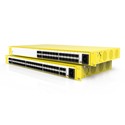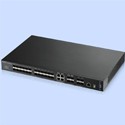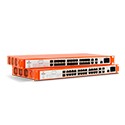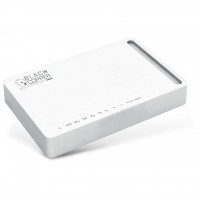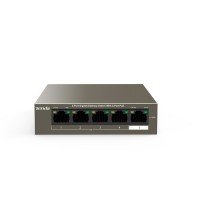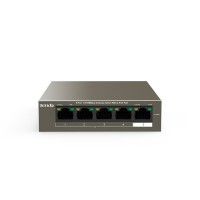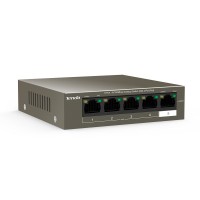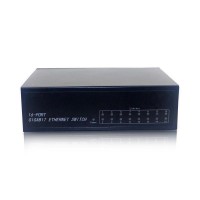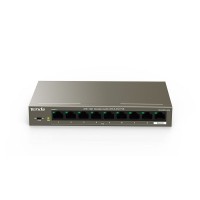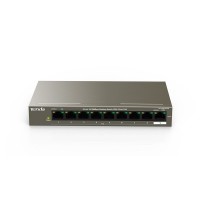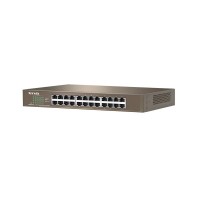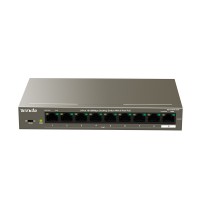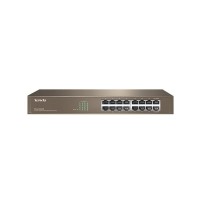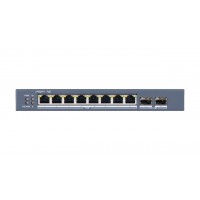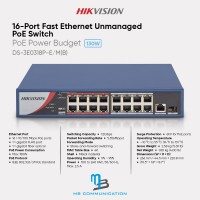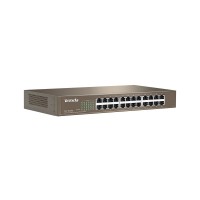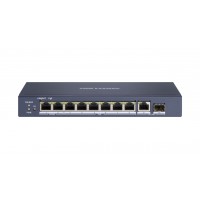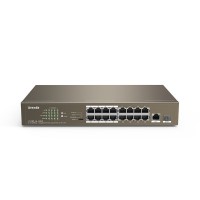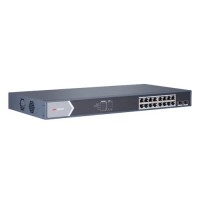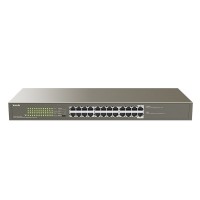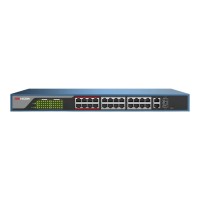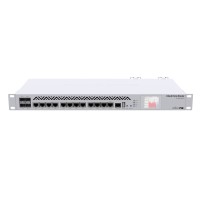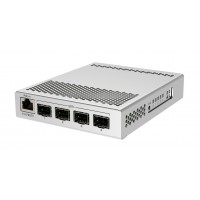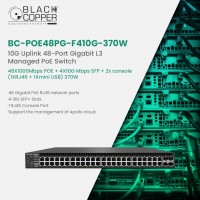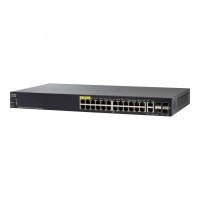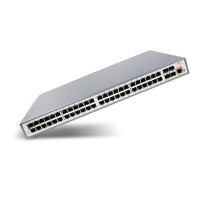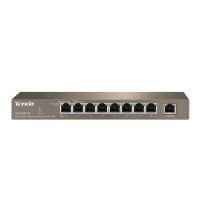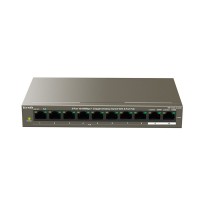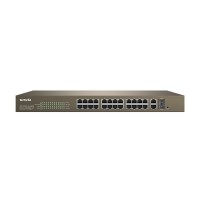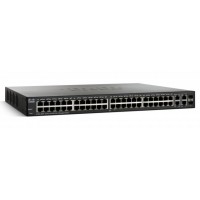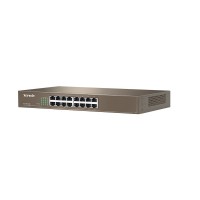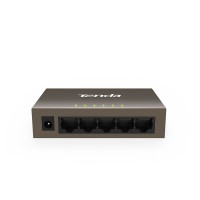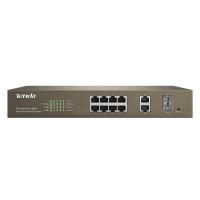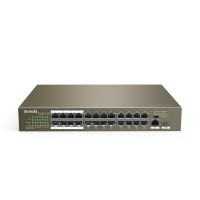No products
Networking Switch
New products
-

BlackCopper BC-EGP-10G015-Z
Transform Your Business with BlackCopper BC-EGP-10G015-Z Dual Screen POS...
Rs 0
Catalog
Networking Switches: The Backbone of Your Network
In today's digital world, reliable and robust network connectivity is crucial for businesses of all sizes. Networking switches play a vital role in facilitating this connectivity by enabling communication between devices within a network. This article will delve into the intricacies of networkin...
Networking Switches: The Backbone of Your Network
In today's digital world, reliable and robust network connectivity is crucial for businesses of all sizes. Networking switches play a vital role in facilitating this connectivity by enabling communication between devices within a network. This article will delve into the intricacies of networking switches, exploring their functions, types, and key considerations for choosing the right switch for your specific needs.
What are Networking Switches?
Networking switches are intelligent network devices that connect multiple devices on a network, allowing them to communicate with each other. They operate at Layer 2 of the OSI model, managing data flow based on MAC addresses. Switches work by learning the MAC addresses of connected devices and creating a dedicated connection between them, unlike hubs that simply broadcast data to all connected devices.
Key Features of Networking Switches:
- Data Forwarding: Switches efficiently forward data packets between devices, eliminating collisions and improving network performance.
- Port Aggregation: Switches enable port aggregation (trunking) to combine multiple physical ports into a single logical channel, increasing bandwidth and redundancy.
- VLAN Support: Virtual Local Area Networks (VLANs) allow you to segment your network into different broadcast domains, enhancing security and improving performance.
- Quality of Service (QoS): QoS features prioritize traffic based on specific applications or users, ensuring critical data flows smoothly.
- Security Features: Many switches include built-in security features such as port security, access control lists (ACLs), and intrusion detection/prevention.
- Management Capabilities: Modern switches offer web-based or command-line interfaces for easy configuration and monitoring.
Types of Networking Switches:
Networking switches are available in various types, each designed for specific network applications and requirements. Here are some common types:
1. Unmanaged Switches:
Unmanaged switches are simple devices that operate without any configuration options. They are typically used in small home or office networks where basic connectivity is sufficient.
2. Managed Switches:
Managed switches provide advanced configuration and management features, allowing network administrators to control various aspects of the network. These switches are suitable for medium to large businesses and enterprise networks that require greater control and flexibility.
3. Smart Switches:
Smart switches offer some management features, such as VLAN support and QoS, but not as extensive as managed switches. They are a cost-effective option for small to medium-sized businesses that require basic management capabilities.
4. Layer 3 Switches:
Layer 3 switches combine Layer 2 switching functions with Layer 3 routing capabilities. They can route traffic between different network segments, reducing the need for dedicated routers. Layer 3 switches are commonly used in larger networks where advanced routing is required.
5. PoE Switches:
Power over Ethernet (PoE) switches provide power to devices connected through Ethernet cables, eliminating the need for separate power outlets. PoE switches are ideal for deploying devices such as IP cameras, wireless access points, and VoIP phones.
Choosing the Right Networking Switch:
Selecting the right networking switch for your network requires considering several factors:
- Network Size and Requirements: Determine the number of devices and ports needed for your network.
- Bandwidth Needs: Consider the data transfer rates required for your applications and the expected network traffic.
- Management Capabilities: Decide whether you need a managed switch with advanced features or an unmanaged switch for basic connectivity.
- Security Features: Assess the security requirements of your network and select a switch that offers appropriate security features.
- Budget: Set a budget for your networking switch and choose a device that provides the best value for your needs.
- Brand Reputation: Consider reputable brands known for their quality, reliability, and customer support.
Best Practices for Networking Switch Installation and Configuration:
Proper installation and configuration are essential for optimizing network performance and reliability. Here are some best practices:
- Plan Your Network Topology: Design a logical network layout that meets your current and future needs.
- Use Quality Cables: Ensure you use high-quality Ethernet cables that meet your network's speed and distance requirements.
- Configure VLANs: If necessary, segment your network into different VLANs for security and performance optimization.
- Set up Security Measures: Enable appropriate security features, such as port security and ACLs, to protect your network from unauthorized access.
- Monitor and Maintain Your Network: Regularly monitor the health and performance of your network and make necessary adjustments.
Benefits of Using Networking Switches:
Investing in a quality networking switch offers numerous benefits, including:
- Improved Network Performance: Switches enhance network speed and efficiency by eliminating data collisions and providing dedicated connections.
- Enhanced Security: Switches provide security features like VLANs, port security, and ACLs to protect your network from unauthorized access and data breaches.
- Scalability and Flexibility: Switches offer scalability to accommodate future network growth and expansion.
- Centralized Management: Managed switches provide a centralized platform for managing and monitoring your network.
- Cost Savings: Switches can help reduce network costs by eliminating the need for dedicated routers in some cases.
Conclusion:
Networking switches are essential components of modern networks, enabling communication between devices and enhancing network performance, security, and scalability. Understanding the different types of switches, their features, and best practices for selection and configuration is crucial for building a reliable and efficient network.
MB Communication, a leading provider of networking solutions, offers a wide range of switches to meet the diverse needs of businesses. Whether you need a basic unmanaged switch for a small home office or a high-performance managed switch for an enterprise network, MB Communication has the solution for you.
Contact MB Communication today to learn more about their networking switch solutions and how they can help you build a robust and secure network.
Networking Switch There are 79 products.
Subcategories
-
Ethernet Switch
Tenda Ethernet Switches: Reliable Connectivity for Your Network
In today's digital age, a reliable and efficient network is essential for businesses and individuals alike. Ethernet switches play a crucial role in connecting devices and facilitating seamless data transfer. Tenda, a renowned network equipment manufacturer, offers a wide range of Ethernet switches designed to cater to diverse networking needs.
What is an Ethernet Switch?
An Ethernet switch is a network device that connects multiple network devices on a local area network (LAN). It acts as a central hub, allowing data to be shared between connected devices without interfering with other traffic. Unlike hubs, switches intelligently forward data packets only to the intended recipient, improving network performance and reducing collisions.
Benefits of Tenda Ethernet Switches
Tenda Ethernet switches offer numerous advantages, making them a popular choice for network connectivity:
- Enhanced Network Performance: Tenda switches utilize advanced technologies to ensure high-speed data transfer and minimize network latency. This results in smoother online experiences, faster file sharing, and improved overall network efficiency.
- Reliable and Stable Connections: Tenda switches are built with robust hardware and software components, guaranteeing reliable and stable connections. Their advanced features, such as auto-negotiation and flow control, further contribute to network stability and minimize connection issues.
- Scalability and Flexibility: Tenda offers a range of switches with varying port counts and speeds, allowing you to choose the optimal option based on your network size and requirements. You can easily expand your network as your needs evolve by adding more switches or upgrading existing ones.
- Easy Setup and Management: Tenda switches are designed with user-friendly interfaces, making them simple to install and configure. Many models also offer intuitive web-based management tools that allow you to monitor and control your network with ease.
- Cost-Effectiveness: Tenda switches provide an excellent balance between performance and affordability. They offer competitive pricing without compromising on quality, making them a cost-effective solution for businesses and individuals of all sizes.
Tenda Ethernet Switches: A Comprehensive Range
Tenda offers a comprehensive range of Ethernet switches to suit various applications and budgets. Here are some popular categories:
1. Unmanaged Switches
Unmanaged switches are simple and easy-to-use devices that require minimal configuration. They are ideal for small networks or home users who need a basic connection without complex settings. Tenda offers a wide selection of unmanaged switches with different port counts and speeds, including:
- Tenda TEG1005D: A 5-port 10/100 Mbps switch with compact design and plug-and-play functionality.
- Tenda TEG1008D: An 8-port 10/100 Mbps switch with desktop design and reliable performance.
2. Managed Switches
Managed switches offer advanced features and control options that allow for more sophisticated network management. These switches are suitable for businesses or organizations that require greater flexibility, security, and network control. Tenda's managed switches feature advanced capabilities, such as:
- VLAN support: Segmenting your network into virtual LANs for enhanced security and traffic isolation.
- QoS (Quality of Service): Prioritizing traffic based on its importance, ensuring smooth performance for critical applications.
- Security features: Protecting your network from unauthorized access and malicious attacks.
3. Gigabit Switches
Gigabit switches provide high-speed data transfer rates, ideal for demanding applications such as streaming 4K video, online gaming, and large file transfers. Tenda offers a range of Gigabit switches with different port counts and features, including:
- Tenda TEG1008D: An 8-port Gigabit switch with high-speed connectivity and compact design.
- Tenda TEG1210P: A 10-port Gigabit switch with PoE (Power over Ethernet) support for powering network devices over the network cable.
Choosing the Right Tenda Ethernet Switch
Selecting the right Tenda Ethernet switch depends on your specific network requirements. Consider the following factors:
- Number of devices: Determine how many devices you need to connect to the switch.
- Data transfer speed: Choose a switch that supports the required data transfer rates for your applications.
- Management features: Decide if you need a managed switch for advanced network control or an unmanaged switch for simpler setup.
- Budget: Tenda offers a variety of switches at different price points, allowing you to find an option that fits your budget.
Why Choose Tenda?
Tenda is a trusted brand known for its high-quality network equipment, reliable performance, and competitive pricing. Their Ethernet switches are widely used in homes, businesses, and organizations, providing reliable connectivity for diverse networking needs.
With its commitment to innovation and customer satisfaction, Tenda continues to deliver advanced networking solutions that enhance network performance, reliability, and security. MB Communication, with its expertise in network solutions, recommends Tenda Ethernet switches as a reliable and cost-effective option for building a robust and efficient network.
-
POE Network Switch
The Ultimate Guide to POE Network Switches: Understanding, Benefits, and Choosing the Right One
In the world of modern networking, Power over Ethernet (PoE) has become an indispensable technology, revolutionizing the way we power and connect devices. PoE network switches play a crucial role in this revolution, offering a streamlined and efficient solution for powering network devices without the need for separate power outlets. This comprehensive guide delves into the intricacies of PoE network switches, exploring their benefits, types, and essential factors to consider when choosing the right one for your needs.
What is a POE Network Switch?
A PoE network switch is a specialized networking device that combines the functionality of a traditional network switch with the ability to deliver power over Ethernet cables. This means that a PoE switch can not only transmit data signals but also supply electrical power to connected devices, such as IP cameras, access points, and VoIP phones, directly through the Ethernet cable.
The Advantages of POE Network Switches
POE network switches offer a multitude of advantages that make them a preferred choice for businesses and individuals alike:
- Simplified Installation: PoE eliminates the need for separate power outlets, simplifying the installation process and reducing clutter. This is particularly beneficial in environments where cabling is complex or access to power outlets is limited.
- Cost Savings: PoE reduces installation costs by eliminating the need for additional power cables and outlets. It also lowers maintenance expenses as fewer power cords and adapters need to be managed.
- Flexibility and Scalability: PoE switches offer flexibility in device placement, allowing you to easily relocate network devices without worrying about power limitations. Their scalability makes them ideal for expanding your network as your needs evolve.
- Enhanced Security: POE eliminates the risk of tripping hazards caused by power cords and reduces the likelihood of accidental disconnections, enhancing network security and stability.
- Centralized Power Management: PoE switches allow you to manage and monitor power consumption for connected devices from a central location, providing greater control and efficiency.
Types of POE Network Switches
POE network switches come in various types, each offering unique features and capabilities:
1. Passive POE Switches
Passive PoE switches simply pass power through the Ethernet cable without any voltage regulation or power management. These switches are typically less expensive but offer limited power delivery capabilities and lack safety features.
2. Active POE Switches
Active PoE switches incorporate power management capabilities, allowing for voltage regulation and protection against overcurrents and short circuits. They offer higher power delivery capacities and provide greater reliability and safety.
3. Standard POE (802.3af)
Standard PoE, defined by the IEEE 802.3af standard, provides up to 15.4 watts of power per port. This type is widely compatible with various devices and is a cost-effective solution for basic networking needs.
4. POE Plus (802.3at)
POE Plus, also known as 802.3at, increases the power output to 30 watts per port, enabling the use of more power-hungry devices like high-performance access points and PTZ cameras.
5. High-Power POE (802.3bt)
High-Power POE, or 802.3bt, delivers even higher power output, ranging from 60 watts to 100 watts per port. This standard is designed to support demanding devices like outdoor access points, surveillance cameras with powerful zoom lenses, and other high-power applications.
Choosing the Right POE Network Switch
Selecting the ideal PoE network switch involves considering several factors:
- Number of Ports: Determine the number of ports you require based on your current and future networking needs.
- Power Budget: Consider the total power consumption of your devices and choose a switch with a sufficient power budget to support them.
- POE Standard: Select a switch that supports the appropriate PoE standard for your devices, such as 802.3af, 802.3at, or 802.3bt.
- Network Speed: Ensure that the switch supports the desired network speed, such as Gigabit Ethernet or 10 Gigabit Ethernet.
- Management Features: Look for switches with advanced management features, such as VLAN support, QoS, and security protocols.
- Budget: Set a budget and choose a switch that provides the best value for your money, balancing features and cost.
MB Communication: Your Reliable Partner for Networking Solutions
MB Communication is a leading provider of innovative networking solutions, offering a wide range of high-quality PoE network switches to meet diverse needs. Whether you're a small business or a large enterprise, MB Communication can help you find the perfect switch for your network infrastructure.
Contact MB Communication today to discuss your networking requirements and explore the power of PoE network switches.
-
Gigabit Ethernet Switch
Gigabit Ethernet Switches: A Comprehensive Guide
In today's interconnected world, businesses and organizations rely heavily on fast and reliable network connections. Gigabit Ethernet switches are essential components for building robust and efficient network infrastructures. This comprehensive guide explores the intricacies of Gigabit Ethernet switches, encompassing their features, benefits, and considerations for choosing the right switch for your needs.
What are Gigabit Ethernet Switches?
Gigabit Ethernet switches are network devices that connect multiple devices on a local area network (LAN) and facilitate communication between them at gigabit speeds. They function as central hubs, enabling data transmission at significantly higher rates than traditional Ethernet switches.
Key Features of Gigabit Ethernet Switches:
- High Bandwidth Capacity: Gigabit Ethernet switches offer significantly higher bandwidth capacity compared to standard Ethernet switches, enabling faster data transfer and reduced network congestion.
- Multiple Ports: They come equipped with multiple ports, ranging from 8 to 48 or more, allowing for the connection of numerous devices to the network.
- Layer 2 Switching: Gigabit Ethernet switches operate at Layer 2 of the OSI model, providing data forwarding and filtering based on MAC addresses.
- VLAN Support: Virtual LAN (VLAN) support enables the segmentation of a network into multiple logical networks, enhancing security and performance.
- QoS Features: Quality of Service (QoS) features allow prioritizing traffic based on specific criteria, ensuring smooth data flow for critical applications.
- Management Options: Gigabit Ethernet switches offer various management options, including web-based interfaces, command-line interfaces, and SNMP support, for configuration and monitoring.
Benefits of Using Gigabit Ethernet Switches:
- Faster Data Transfer Rates: Gigabit Ethernet switches provide significantly faster data transfer rates compared to traditional Ethernet switches, resulting in improved network performance and responsiveness.
- Enhanced Network Reliability: They offer high reliability, minimizing network downtime and ensuring continuous connectivity.
- Increased Network Scalability: Gigabit Ethernet switches support a larger number of connected devices, enabling network expansion and accommodating future growth.
- Improved Security: Features like VLAN support and port security enhance network security by isolating traffic and preventing unauthorized access.
- Cost-Effective Solution: Gigabit Ethernet switches provide a cost-effective solution for building high-performance networks, offering a balance between functionality and affordability.
Factors to Consider When Choosing a Gigabit Ethernet Switch:
- Number of Ports: Determine the required number of ports based on the number of devices to be connected.
- Bandwidth Requirements: Consider the bandwidth requirements of your applications and the expected data traffic volume.
- Management Features: Evaluate the management options and features offered by different switches to ensure ease of configuration and monitoring.
- Security Features: Determine the level of security features required, such as VLAN support and port security, to protect your network.
- Power Consumption: Consider the power consumption of the switch, especially for larger deployments.
- Budget: Set a budget and choose a switch that fits your financial constraints.
Types of Gigabit Ethernet Switches:
- Managed Switches: Offer advanced configuration options, VLAN support, QoS features, and comprehensive management capabilities.
- Unmanaged Switches: Simple and plug-and-play devices, typically suitable for small networks with basic requirements.
- Stackable Switches: Allow multiple switches to be stacked together, creating a single logical switch for increased capacity and scalability.
- PoE Switches: Provide power over Ethernet (PoE), allowing devices like IP cameras and wireless access points to be powered through the network cable.
Popular Gigabit Ethernet Switch Brands:
There are many reputable Gigabit Ethernet switch manufacturers in the market, including:
- BlackCopper
- D-Link
- MikroTik
- Cisco
- Netgear
- TP-Link
Conclusion:
Gigabit Ethernet switches are essential components for building modern and efficient network infrastructures. By understanding their features, benefits, and considerations, businesses and organizations can choose the right switch to meet their specific requirements and enhance their network performance, scalability, and security. MB Communication, with its expertise in networking solutions, can assist you in selecting the optimal Gigabit Ethernet switch for your needs.
-
Black Copper BC-B08G
BC-B08G 8 Port Gigabit Desktop Switch 1000Mbps5-8 gigabit ports greatly expands network capacityand enables instant large files transferring. Plug and PlayNo configuration required, simply plug and playfor easy use.
Rs 4,390Out of stock -
Tenda TEG1105P-4-63W
TEG1105P-4-63W / Switch / 5-Port Gigabit Desktop Switch with 4-Port PoE TEG1105P-4-63W is a Tenda PoE switch that offers 5 10/100/1000 Mbps Base-TX RJ45 ports.
Rs 4,500Out of stock -
-
Tenda TEF1105P-4-63W
5-Port 10/100Mbps Desktop Switch with 4-Port PoE TEF1105P-4-63W is a Tenda PoE switch that offers 5 10/100 Mbps Base-TX RJ45 ports. Up to 250 meters long distance transmission, beyond hundred meters transfer limit. 6KV lightning protection PoE switch is the real monitoring private switch.
Rs 6,360Out of stock -
Black Copper BC-16PGM
Black Copper BC-16PGM 16 Ports gigabit switch 16 Ports gigabit switch desktop switch networks 10/100/1000Mbps ethernet switch
Rs 6,470Out of stock -
Tenda TEF1109TP-8-102W
8FE+1GE Desktop Switch With 8-Port PoE TEF1109TP-8-102W is an 8FE+1GE Desktop Switch With 8-Port PoE developed by Tenda.
Rs 8,200Out of stock -
Tenda TEF1109P-8-63W
TEF1109P-8-63W / Switch / 9-Port 10/100Mbps Desktop Switch With 8-Port PoE TEF1109P-8-63W Up to 250 meters long distance transmission, beyond hundred meters transfer limit.6KV lighting protection PoE switch is the real monitoring private switch .Ports 1-8 support IEEE 802.3at and IEEE 802.3af PoE standard. It provides 30W maximum PoE output a...
Rs 8,800Out of stock -
Tenda TEG1024D
TEG1024D v7 / Switch / 24-Port Gigabit Ethernet Switch The Tenda TEG1024D 24*10/100/1000 Mbps auto-negotiation RJ45 ports, up to 2000 Mbps of full duplex transmission rate
Rs 10,500Out of stock -
Tenda TEF1109P-8-102W
9-Port Fast Unmanaged Switch With 8-Port PoE TEF1109P-8-102W is a Tenda switch that offers 9 10/100M RJ45 ports. Ports 1-8 comply with the IEEE802.3af standard (maximum PoE power output : 15.4w) and 802.3at standard (maximum PoE power output: 30W). The switch offers a maximum PoE power output of 92W and can supply power to exchange data with APs, IP...
Rs 10,760Out of stock -
Tenda TEG1016D
TEG1016D v6 / Switch / 16-Port Gigabit Ethernet Switch The Tenda TEG1016D 16*10/100/1000 Mbps auto-negotiation RJ45 ports, up to 2000 Mbps of full duplex transmission rate
Rs 18,340Out of stock -
Hikvision DS-3E1510P-E
8 Port Gigabit Web POE Switch 8 × gigabit PoE ports, and 2 × gigabit fiber optical ports IEEE 802.3at/af standard for PoE ports IEEE 802.3, IEEE 802.3u, IEEE 802.3x, IEEE 802.3ab, and IEEE 802.3z standard 6 KV surge protection for PoE ports. AF/AT camera can reach up to 300 m in extend mode PoE watchdog to auto detect and restart the cameras that do not...
Rs 18,340Out of stock -
Hikvision DS-3E0318P-E-M(B)
16 Port Fast Ethernet Unmanaged POE Switch Intelligent PoE Management. When the power supply exceeds the limit, PoE ports intelligently manage the power supply, which extends the switch lifetime. Up to 300 m Long Range PoE Transmission. The distance between IPCs and switch can reach maximum 300 meters.
Rs 20,020Out of stock -
Tenda TEF1024D
TEF1024D / Switch / 24-Port 10/100 Switch Tenda TEF1024D 24-Port 10/100 Switch is specially engineered to provide simple solution to expand SMB networks and campus networks at the best possible cost.
Rs 20,170Out of stock -
Hikvision DS-3E0510HP-E
8 Port Gigabit Unmanaged POE Switch 6 × gigabit PoE ports, 2 × gigabit Hi-PoE ports, 1 × gigabit RJ45 port, and 1 × gigabit fiber optical port. IEEE 802.3at/af/bt standard for Hi-PoE ports (Max. 90 W PoE output). IEEE 802.3at/af standard for PoE ports (Max. 30 W PoE output). IEEE 802.3, IEEE 802.3u, IEEE 802.3x, IEEE 802.3ab, and IEEE 802.3z standard.
Rs 26,900Out of stock -
Tenda TEF1118P-16-150W
TEF1118P-16-150W / Switch / 16 10/100Mbps +1 Gigabit/SFP Slots Switch With 16-Port PoE TEF1118P-16-150W is a Tenda PoE switch that offers 16 10/100 Mbps Base-TX RJ45 ports
Rs 28,080Out of stock -
HikVision DS-3E0518P-EM
16 Port Gigabit Unmanaged POE Switch 16 × Gigabit PoE ports, 2 × Gigabit SFP fiber optical ports IEEE 802.3at/af standard IEEE 802.3, IEEE 802.3u, and IEEE 802.3x standard 6 KV surge protection for PoE ports PoE power management Gigabit network access Wire-speed forwarding Store-and-forward switching Solid high-strength metal shell
Rs 36,400Out of stock -
Tenda TEG1124P-24-250W
1000M&PoE 24-Port Gigabit Ethernet Switch with 24-Port PoE
Rs 52,620Out of stock -
Hikvision DS-3E1326P-E
Smart Managed 24-Port 100 Mbps PoE Switch The DS-3E1326P-E is a 10/100 Mbps web-managed switch that is designed for IP surveillance applications. Easily configured via a Web interface, users can setup VLANs, port mirroring, SNMP, and more.
Rs 67,260Out of stock -
MikroTik CCR1036-12G-4S-EM
1U rackmount, 12x Gigabit Ethernet, 4xSFP cages, LCD, 36 cores x 1.2GHz CPU, 8GB RAM, 24 mpps fastpath, Up to 16Gbit/s throughput, RouterOS L6, Dual PSU
Rs 91,720Out of stock -
Mikrotik CRS305-1G-4S-IN
Five-port desktop switch with one Gigabit Ethernet port and four SFP+ 10Gbps ports The CRS305 is a compact yet very powerful switch, featuring four SFP+ ports, for up to 10 Gbit per port. The device has a 1 Gbit copper ethernet port for management access or regular traffic forwarding and two DC jacks for power redundancy.
Rs 91,720Out of stock -
Black Copper BC-POE48PG-F410G-370W
10G Uplink 48-Port Gigabit L3 Managed PoE Switch 48X1000Mbps POE + 4X10G Mbps SFP + 2x console (1XRJ46 + 1Xmini USB) 370W BC-POE48PG-F410G-370W is a managed PoE switch specially designed for security transmission and WIFI coverage. It can meet the PoE power supply requirements of various types of devices such as WIFI AP, IP-camera, WIFI bridge and IP phone.
Rs 156,000Out of stock -
Cisco SG350-28P-K9
The Cisco 350 series part of the cisco small business line of network solutions is a portfolio of affordable managed switches that provides a reliable foundation for your business network These switches deliver the features you need to improve the availability of your critical business applications protect your sensitive information and optimize your...
Rs 226,260Out of stock -
Black Copper BC-POE048PF
51-Port Gigabit Black Copper PoE Fiber Switch The BC-POE048PF series is an unmanaged PoE fiber switch independently developed by SF.It has 48*10/100M RJ45 ports and 3*10/100M Black Copper RJ45 ports and 2*1000M Black Copper SFP slot ports (combo port). Port 1-48 can support IEEE 802.3af/at standard PoE power supply.
Rs 0Out of stock -
Tenda TEG1009P-EI
TEG1009P-EI / Switch / 9-Port Gigabit Desktop Switch with 8-Port PoE Tenda TEG1009P-EI is 9-Port Gigabit Desktop Switch with 8-Port PoE, providing 9 GE Base-T Ethernet ports. 1-8 ports supports IEEE802.
Rs 0Out of stock -
Tenda TEF1110P-8-102W
TEF1110P-8-102W / Switch / 8-Port10/100Mbps+2 Gigabit Desktop Switch With 8-Port PoE TEF1110P-8-102W 8-Port10/100Mbps+2 Gigabit Desktop Switch With 8-Port PoE
Rs 0Out of stock -
Tenda TEF1226P-24-440W
TEF1226P-24-440W / Switch / 24-Port 10/100Mbps + 2 Gigabit Web Smart PoE Switch Tenda TEF1226P switch supports 24 PoE ports, which can supply power to most powered devices through 8-core Ethernet cable, and the total PoE power can be up to 370 W while each PoE port can support the maximum of 40 W.
Rs 0Out of stock -
Cisco SF300-48P
Cisco SF300-48P 48-Port 10/100 PoE Managed Switch with Gigabit Uplinks
Rs 0Out of stock -
Tenda TEF1016D
TEF1016D / Switch / 16-Port 10/100 Switch Tenda TEF1016D 16-Port 10/100 Switch is specially engineered to provide simple solution to expand SMB networks and campus networks at the best possible cost.
Rs 0Out of stock -
Tenda TEF1005D
TEF1005D / Switch / Fast 10/100Mbps 5-port fast ethernet switch Tenda TEF1005D 5 * 10/100Mbps auto-negotiation RJ45 ports that support line-speed forwarding and large-capacity cache
Rs 0Out of stock -
Tenda TEF1210P-8-150W
TEF1210P-8-150W / Switch / 8-Port 10/100Mbps + 2 Gigabit Web Smart PoE Switch Tenda TEF1210P switch supports 8 PoE ports, which can supply power to most powered devices through 8-core Ethernet cable, and the total PoE power can be up to 123 W while each PoE port can support the maximum of 40 W.
Rs 0Out of stock -
Tenda TEF1126P-24-250W
TEF1126P-24-250W / Switch / 24 10/100Mbps +1 Gigabit/SFP Slots Switch With 24-Port PoE TEF1126P-24-250W is a Tenda PoE switch that offers 24 10/100 Mbps Base-TX RJ45 ports.
Rs 0Out of stock





